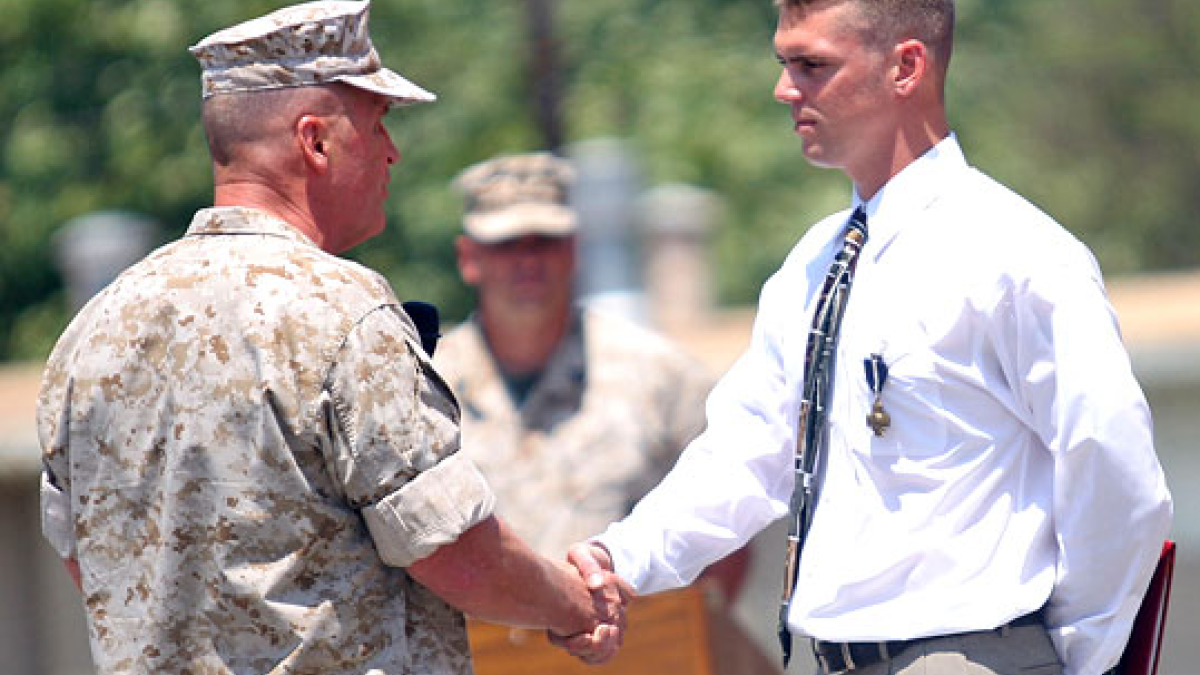Sun Devil veteran reflects on time in Marine Corp, receiving Navy Cross

In the face of danger, it takes a hero to stand and fight for what he believes in. For Robert Mitchell, Jr., a student at Arizona State University and veteran, that meant protecting his country and military brothers when all hope seemed gone.
After growing up in both Iowa and Nebraska, Mitchell joined the Marine Corp in February of 2001. He went on to complete three deployments and two combat tours of Iraq as an Infantry Specialist. During this time he traveled to Hawaii, Singapore, Africa, Australia and Guam, fulfilling his desire for a change of environment and new life experiences.
“Most of my family are veterans, and growing up I read a lot of books that led me to believe the Marines were the toughest and most close-knit group. I realized that if I didn’t go and have those experiences that I would regret it,” said Mitchell.
In 2006, he was bestowed the Navy Cross, the second-highest decoration behind the Medal of Honor, given to those who exemplify distinguished acts of combat valor. Mitchell earned the award after a deployment to Fallujah, Iraq, where he saved the lives of several Marines who were trapped inside of a squat while enemy forces fired countless rounds of ammunition inside.
Mitchell interchanged between battling the rivals and providing medical assistance to his injured troops. As a trained medic, he was able to tend the wounds of those inside before his fellow squad members assisted the trapped Marines to safety. In the process, Mitchell was hit with shrapnel on his face and legs but did not show any concern for his injuries. His main focus was to save the men whom he considered family.
“In those situations you just react and decide how to gain the upper hand. Your training takes over and you forget about everything else because one of your guys is injured and you have to be there for him,” said Mitchell.
Soon after receiving the Navy Cross, Mitchell decided to leave the service. For him, leaving his friends and becoming a civilian was the hardest adjustment.
“There are so many good memories that stick out to me. Even with that situation in Fallujah, I’m now so much closer to the guys I was with there that it outweighs any of the bad,” he recalls. “That’s what you miss the most about the service – the comradery. When you think you are in the worst situation possible, whether it’s in training or in combat, there is always someone who know just what to say to make light of the situation.”
When asked about the most important lesson he learned from his experiences, Mitchell humbly responds by giving credit for his success to the Marine Corps and his fellow troop members.
“You can’t be a hero by yourself. I would read comic books as a kid and liked the X-Men because it was a group. It wasn’t just one of them defeating bad guys or accomplishing tasks, it is a whole group of them like in the Marines,” he said.
After earning his associate degree at Gilbert Community College, Mitchell came to Arizona State University on a scholarship to continue his education. Majoring in mechanical engineering, he takes one course a semester while supporting his family with a full-time job.
“I love school, and it’s great to go to a veteran-friendly school. I think that for veterans who don’t know much about their GI Bill, or who are looking to use their GI Bill, the Tillman Center is a great place for them to go,” he said.
Upon earning his degree from ASU, Mitchell plans to open his own engineering consulting firm, in which he will also manufacture and sell parts to businesses globally. He also looks forward to continuing to spend time with his family.
In the meantime, Mitchell says the leadership skills that he learned in the military are still being put to good use in his current position where he manages a 20-person production team in the aerospace industry.

